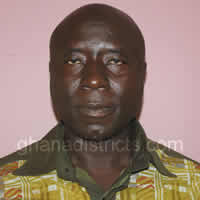Size and Distribution of Population
The population of the municipality is currently 88,625 (2008 projection), as against 78,056 as at (Ghana Population and Housing Census 2000). The municipality experienced a marginal increase in population growth. The current projected growth rate is 1.4% as against 1.6% of the 2000 population and house census. A critical look at the trend thus reveals a rise, having stabled in 1984. The size and growth rate of population of the municipality is presented.
Spatial Distribution of Population
The population of the Municipality is fairly distributed. However, the lager towns have relatively larger populations as compared to the smaller towns/communities. Sample of ten communities and their projected populations (2006-2009) is shown in the table below.
Whilst the relatively bigger towns continue to experience increase in population as a result of migration and increase in birth rate, the rural communities are experiencing decrease in population as shown in the table below. Nonetheless, the rural settlements of the Municipality enjoy the greater percentage of the Population (61%).
Household Sizes/Characteristics
The current average Household size of 6.4 is higher than the National figure of 5.24 and the 1995 survey figure of 5.5 of the District showing an increase due to the growth of the population. The implication is that each Household has a large number of Dependants to feed, cloth and house. Given the low average Household Income, most families have a low Living Standard as evidenced by both Income and Expenditure pattern where the bulk of family income goes into food.
Age and Sex Composition
According to the 2000 Population and Housing Census, females out-numbered the males in the Municipality. From the census, the females formed 51.3% of the total population whilst males constituted 48.7% with age-dependency ratio of 1:0.7. This trend is expected to remain unchanged, through the Plan period (2006-2009).
Implications of Age-Sex Composition for Development
1. The population has a growth potential for accelerated economic growth and development
2. The Assembly should improve upon the educational and health infrastructure facilities and also create job opportunities for the increasing number of the youth.
3. The Active Labour Force (59.3) of those between 15 and 64 is a potential which could be used for development in form of communal labour, collection of development levies and investment attractions.
Labour Force (Including Child Labour)
The Municipality’s population is relatively youthful with 59.3% in active labour force higher than the national figure of 51%. The Aged constituted 5.2%.
Migration Trend
The Assembly experiences relatively mild migration mostly from the rural communities to the urban areas. Other form of migration has to do with the movement down south as pertain in the country as a whole.
Rural - Urban Split
The Municipality is generally rural in nature. About 36.5% of the population resides in urban centers as compared to the National figure of 32% (2000 Population and Housing census). The urban communities are Mampong, with a population percentage of about 17.7% of the entire population of the municipality, while Kofiase, Ninting, Asaam, Nkwanta, Kyekyewere, Apaah, Yonso have 8.6%, 2.6%, 2.1%, 1.6%, 1.4%, 1.4%, and 1.6% respectively. The municipality’s rural population of about 63.7% is distributed among villages and hamlets scattered throughout the municipality.
The Municipality Rural population of about 63.7% is distributed among villages and hamlets scattered throughout the District. It is anticipated that due to the seasonality of farming activities in the Municipality -giving rise to under employment within the Municipal, the assumption is that more people will be attracted to the Urban Centres in future in search of non-existing jobs, thereby increasing the urban population. The existing social facilities will be put under severe pressure and agricultural production will be low since almost all the able-bodied labour force source will come to the Urban Centres.
Therefore, it is imperative to lay emphasis on rural strategy of development and at the same time providing the needed Infrastructural facilities to enable the few Urban Settlements perform the roles as Service Centres.
Spatial Analysis
Looking at the settlement patterns at a glance, one can see that settlements are skewed towards the western part of the Municipality. In the other half, the settlements are mostly found in the north with virtually no settlements in the south. The settlements are of different hierarchies and perform different functions.
Settlement Hierarchy and Scalogram Analysis
A Scalogram (Functional Matrix) and a hierarchy of settlements map is drawn for the Municipal based on the level of services and the population size in the 30 big towns . Services were grouped under Education, Security, Commerce, Agric/Forestry,Health, Water, and Sanitation etc.
Mampong the Municipal capital is the most well endowed town in the Municipality. It is the most densely populated town in the district and the only town with a population of over 10,000 inhabitants. There are services like tertiary education, hospital, pipe borne water, electricity, high court, telephone services and banks.There was no 2nd level settlement because of the big disparity between Mampong and the next most important towns in terms of population and level of services.
The 3rd level of settlements was Nsuta, Kofiase, Kwamang, Kyebi, and Beposo. These communities have population between 4000 and 7000. These settlements have Health Facilities, Education, Banks, Boreholes, etc.
The 4th level of settlement, which forms the majority, had population between 2000 and 4000. They are towns like Amoamang, Kyekyewere, Mprim, Birem, Yonso etc.
The last group of Settlements, which form the majority, includes towns like, Asuafo, Mpantuase, Fawoman, Mantukwa etc. They had population of less than 1000 inhabitants.
A study of the Scalogram indicates that the level of services in Mampong and its catchments area is high due to its importance as the economic and Administrative Capital of the Municipality. The Afram plains portion of the Municipality is less endowed and therefore sparsely populated. The disparity in population between the two areas is attributed to the differences in terms of services and facilities. There is the need to provide services like good housing, water, and electricity in the less endowed areas to make the youth stay there.
Scalogram and Weighted Centrality Indices Analysis
The scalogram is primarily a graphic device that illustrates in the form of a matrix chart the spatial distribution of functions of all selected settlements in a Locality or Municipality by their frequency of presence or absence. The Scalogram gives a good practical impression about the functions that settlements perform in a particular locality. Based on the number and type of service and facilities available (that is the scalogram), the Centrality Indices of selected Settlements are analyzed, which eventually leads to the ranking of the Settlements.
In constructing the Scalogram, a total of 32 functions were considered on presence or absence basis for all the selected Settlements. It should be noted that the number and types of functions included are generally services and facilities present in the locality in question. The settlements in the Municipal included in the analysis were selected using population size of 500 for special development purposes, which are mostly in the Afram Plains. Initially Settlements are ranked according to population size in descending order of magnitude.
However, this magnitude changes when the functions that exist in a particular settlement are taken into account. The hierarchy that finally comes out is based on the centrality index, which measures the relative importance of facilities and services present in the Settlement. Thus the functions are assigned a weight, which is inversely proportional to the frequently with which they occur. Therefore, the centrally index for a settlement is the sum of weights of the functions found there. The higher the index the greater its functional complexity.
Date Created : 11/27/2017 7:51:55 AM




